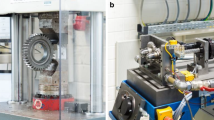Abstract
In this study, the effect of different case-hardening treatments on microstructure, hardness distribution, surface roughness parameters, and dimensional changes was investigated for helical-toothed gears made of 16MnCr5 and 21NiCrMo2 steels. Gas carburizing, gas carburizing–double quenching, low-pressure carburizing, and plasma-nitriding treatments were performed as case-hardening processes. The surface characteristics and distortion analyses of the case-hardened helical gears were examined using an optical microscope, hardness tester, profilometer, and micrometer. In order to ensure adequate pitting and bending strength, the required minimum effective case depth and minimum total case depth values were provided by the performed case-hardening treatments. In the gears, the largest dimensional increase after the heat treatments occurred at the end of the gas carburizing due to the long treatment times at high processing temperatures. The surface roughness values obtained through all performed case-hardening treatments necessitated the finishing processes.





Similar content being viewed by others
References
Fernandes C M C G, Battez A H, González R, Monge R, and Viesca J L, García A, Martins R C, and Seabra J H O, Tribol Int90 (2015) 306. https://doi.org/10.1016/j.triboint.2015.04.037.
Dengo C, Meneghetti G, and Dabalà M, Int J Fatigue80 (2015) 145. https://doi.org/10.1016/j.ijfatigue.2015.04.015.
Savaria V, Monajati H, Bridier F, and Bocher P, J Mater Process Technol220 (2015) 113. https://doi.org/10.1016/j.jmatprotec.2014.12.009.
Hippenstiel F, Bleck W, Clausen B, Hoffmann F, Kohlmann R, and Pouteau P, Härterei-Technische Mitteilungen57 (2002) 290.
ANSI/AGMA 2004-B89, Amerıcan National Standard, Gear Materials and Heat Treatment Manual, American Gear Manufacturers Association (1989).
Krauss G, Microstructures and Properties of Carburized Steel, in Heating, ASM Handbook, ASM International, Materials Park, Ohio (1991), p 363.
Davis J R, Surface Hardening of Steels: Understanding the Basics, ASM International, Materials Park (2002), p 91.
Poor R P, Barbee W, and Brug J E, US Patent No. 7, 267, 793 B2, United States Patent Application Publication (2007).
Cho J R, Kang W J, Kim M G, Lee J H, Lee Y S, and Bae W B, J Mater Process Technol153–154 (2004) 476. https://doi.org/10.1016/j.jmatprotec.2004.04.131.
Garcia Navas V, Gonzalo O, Quintana I, and Pirling T, Mater Sci Eng A528 (2011) 5146. https://doi.org/10.1016/j.msea.2011.03.004.
Józwiak W K, Góralski J, Maniecki T P, Kula P, and Pietrasik R, Chem Eng, 82 (2003) 710.
ASTM E92, Standard Test Methods for Vickers Hardness and Knoop Hardness of Metallic Materials, ASTM International, West Conshohocken, PA (2017).
Kutay MG, http://www.guven-kutay.ch/disliler/12_00_disliler_genel.pdf, (accessed 10 August 2019).
ANSI/AGMA 2001-D04, Amerıcan National Standard, Fundamental Rating Factors and Calculation Methods for Involute Spur and Helical Gear Teeth, American Gear Manufacturers Association (2004).
Smith E H, Mechanical Engineer’s Reference Book, Butterworth Heinemann, Oxford (1998).
Kardonina NI, Yurovskikh AS, and Kolpakov A S, Met Sci Heat Treat + 52 (2011) 457. https://doi.org/10.1007/s11041-010-9301-y.
Kula P, Pietrasik R, and Dybowski K, J Mater Process Technol164–165 (2005) 876. https://doi.org/10.1016/j.jmatprotec.2005.02.145.
Radzevich S P, Dudley’s Handbook of Practical Gear Design and Manufacture, CRC Press, Boca Raton (2012), p 309.
Tobie T, Hippenstiel F, and Mohrbacher H, Metals7 (2017) 415. https://doi.org/10.3390/met7100415.
Blawert C, Mordike B L, Huchel U, Stramke S, Collins G A, Short K T, and Tendys J, Surf Coat Technol98 (1998) 1181. https://doi.org/10.1016/S0257-8972(97)00232-6.
Wang Q, Zhang L, and Shen H, Surf Coat Technol 205 (2010) 2654. https://doi.org/10.1016/j.surfcoat.2010.10.031.
Sun W, and Lancaster A J, Surface Texture Measurements of Gear Surfaces Using Stylus Instruments, National Physical Laboratory, Good Practice Guide No:147 (2017).
Randak A, and Eberbach R, HTM Härterei-Technische Mitteilungen24 (1969) 201.
Author information
Authors and Affiliations
Corresponding author
Additional information
Publisher's Note
Springer Nature remains neutral with regard to jurisdictional claims in published maps and institutional affiliations.
Rights and permissions
About this article
Cite this article
Gençoğlu, S., Yazıcı, A. Surface Characteristics and Distortion Analysis of the Case-Hardened Helical Gears: A Comparison of Different Case-Hardening Treatments. Trans Indian Inst Met 73, 119–126 (2020). https://doi.org/10.1007/s12666-019-01810-0
Received:
Accepted:
Published:
Issue Date:
DOI: https://doi.org/10.1007/s12666-019-01810-0




